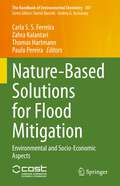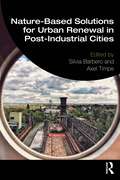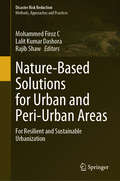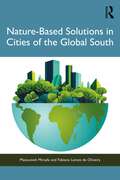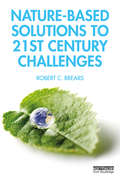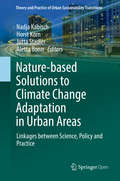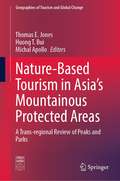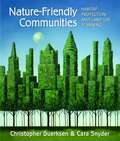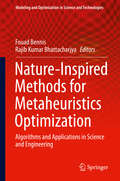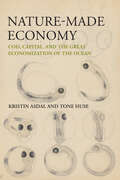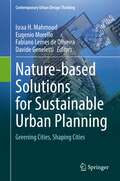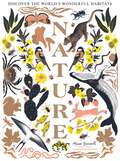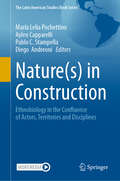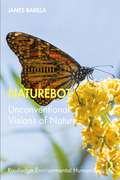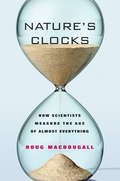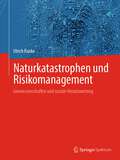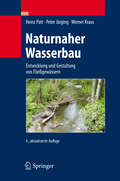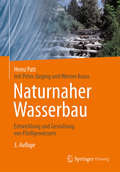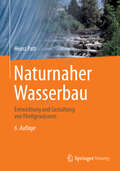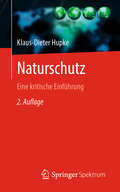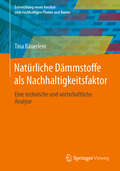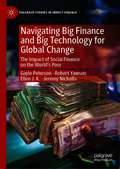- Table View
- List View
Nature-Based Solutions for Flood Mitigation: Environmental and Socio-Economic Aspects (The Handbook of Environmental Chemistry #107)
by Thomas Hartmann Paulo Pereira Carla S. S. Ferreira Zahra KalantariThis book provides an overview of the typical nature-based solutions (NBS) used for flood mitigation at different scales and in different areas (e.g. from catchment to hillslope scale; from urban to coastal areas). NBS can provide several ecosystem services, such as water regulation and water quality enhancement, and as such offer relevant technical solutions to complement typical grey infrastructures to mitigate flood hazard and water quality problems. In recent years, political awareness and interest from the scientific community have led to increasing implementation of NBS worldwide. In light of this trend, this book provides valuable insights into the environmental aspects of NBS, particularly their effectiveness for flood and pollution mitigation, and discusses socio-economic aspects related to the implementation of NBS, including regulatory aspects, cost, and citizens’ perceptions of NBS. Compiling the latest research, the book furthers our understanding of the role of NBS for flood mitigation and its relation to environmental aspects, to guide scientists and stakeholders in future NBS projects. It is intended for the scientific community and stakeholders, such as spatial planners and landscape managers.Chapter "Nature-based solutions for flood mitigation and resilience in urban areas" is available open access under a Creative Commons Attribution 4.0 International License via link.springer.com.
Nature-Based Solutions for Urban Renewal in Post-Industrial Cities
by Silvia Barbero Axel TimpeThis book, based on the experiences and insights gained during the Horizon 2020 project proGIreg, offers a detailed overview of targeted nature-based solutions and their impacts on various key sustainability areas, guiding readers through the spatial analysis, co-design, and implementation processes of cities in Europe and Asia. Chapters shed light on the challenges and opportunities encountered in each location, including Germany, Italy, Croatia, Bosnia and Herzegovina, Greece, Portugal, Romania and China. It also shares essential lessons learned and a wide range of indicators crucial for assessing the benefits of nature-based solutions on social innovation, circular economy, biodiversity, and health. Finally, the focus of this book shifts to the future of nature-based solutions as catalysts for new and green community economies as well as policies aimed at addressing climate change and urban renewal. The lessons and insights from the projects highlighted in this book will be valuable for urban planners and policymakers worldwide, as well as for a broader audience interested in nature-based solutions and urban regeneration.The Open Access version of this book, available at www.taylorfrancis.com, has been made available under a Creative Commons CC-BY 4.0 license.
Nature-Based Solutions for Urban and Peri-Urban Areas: For Resilient and Sustainable Urbanization (Disaster Risk Reduction)
by Rajib Shaw Mohammed Firoz C Lalit Kumar DashoraThis book explores the concept of nature-based solutions (NbS) as a sustainable approach to tackle the environmental challenges in urban and peri-urban areas such as biodiversity loss and urbanization in the changing climate. The book highlights the myriad benefits of NbS, including enhancing resilience, mitigating urban heat island effect, promoting biodiversity, and improving air and water quality. Drawing on real-world case studies from different global contexts, the book provides practical examples of successful NbS implementation in various urban and peri-urban settings. Through an interdisciplinary lens, the book discusses the science, policy, and governance aspects of NbS, emphasizing the need for collaboration among stakeholders, policymakers, and communities to effectively implement the solutions. It will also explore the economic benefits of NbS and how they can contribute to the well-being and social equity of urban populations. The book serves as an essential guide for policymakers, researchers, and practitioners seeking sustainable and nature-centric approaches to address the environmental challenges that cities and peri-urban areas face in the twenty-first century.
Nature-Based Solutions in Achieving Sustainable Development Goals: Harmonizing Nature and Progress
by Pardeep Singh Prateek Srivastava Alexander SorokinThis book provides a comprehensive guide to leveraging nature-based economic initiatives for sustainable rural development. The book covers a wide range of topics, including promoting agroecology and sustainable fisheries for achieving food security, ecosystem-based approaches for water resource management, nature-driven renewable energy systems, and nature-based urban resilience. The book also explores the impact of nature-based interventions on ecosystems and human health, augmenting carbon sink capacities, ecological conservation and sustainable management of marine environments, ecosystem restoration and biodiversity conservation for land stewardship, and promoting multi-stakeholder collaboration for nature-based sustainable development. The book presents a didactic approach, with illustrations, tables, and a new form of presentation that makes it easy to understand and apply the concepts. The methods, results, and topics covered in the book will be of particular interest to readers interested in sustainable development, environmental conservation, and rural development. The book provides readers with a deep understanding of nature-based solutions and their potential to address societal challenges through the protection, sustainable management, and restoration of both natural and modified ecosystems. The main benefit that readers will derive from the book is a comprehensive understanding of nature-based solutions and their potential to address major challenges like climate change, disaster risk reduction, food and water security, biodiversity loss, and human health. The book provides readers with practical solutions to leverage nature-based economic initiatives for sustainable rural development. The book is an essential resource for policymakers, researchers, practitioners, and students interested in sustainable development, environmental conservation, and rural development.
Nature-Based Solutions in Cities of the Global South
by Masoumeh Mirsafa Fabiano Lemes de OliveiraThis book explores the practice of Nature-Based Solutions (NBS) in the cities of the Global South. NBS are recognized as a key strategy for achieving sustainable development, and they are being implemented in a variety of sectors such as urban planning, agriculture, forestry, and water management. They offer a wide range of benefits, but there is a gap between research and practice across cities from the Global South. This book promotes implemented urban NBS projects in the Global South to help identify region-specific challenges and opportunities, and to develop more effective and equitable solutions. The presented case studies support resilient planning in the Global South and significantly inform urban debates in the Global North. This book offers pragmatic policy and planning recommendations, providing decision-makers with clear guidance on implementing NBS in urban settings and transforming knowledge into actionable strategies for sustainable and resilient urban development.
Nature-Based Solutions to 21st Century Challenges
by Robert C. BrearsThis book provides a systematic review of nature-based solutions and their potential to address current environmental challenges. In the 21st century, society is faced by rapid urbanisation and population growth, degradation and loss of natural capital and associated ecosystem services, an increase in natural disaster risks, and climate change. With growing recognition of the need to work with ecosystems to resolve these issues there is now a move towards nature-based solutions, which involve utilising nature’s ecosystem to solve societal challenges while providing multiple co-benefits. This book systematically reviews nature-based solutions from a public policy angle, assessing policy developments which encourage the implementation of nature-based solutions to address societal challenges while simultaneously providing human well-being and biodiversity benefits. This includes enhancing sustainable urbanisation, restoring degraded ecosystems, mitigating and adapting to climate change, and reducing risks from natural disasters. While nature-based solutions can be applied strategically and equitably to help societies address a variety of climatic and non-climatic challenges, there is still a lack of understanding on how best to implement them. The book concludes by providing a best practice guide for those aiming to turn societal challenges into opportunities. This book will be of great interest to policymakers, practitioners and researchers involved in nature-based solutions, sustainable urban planning, environmental management, and sustainable development generally.
Nature-Based Solutions to Climate Change Adaptation in Urban Areas: Linkages between Science, Policy and Practice (Theory and Practice of Urban Sustainability Transitions)
by Aletta Bonn Nadja Kabisch Horst Korn Jutta StadlerThis open access book brings together research findings and experiences from science, policy and practice to highlight and debate the importance of nature-based solutions to climate change adaptation in urban areas. Emphasis is given to the potential of nature-based approaches to create multiple-benefits for society.The expert contributions present recommendations for creating synergies between ongoing policy processes, scientific programmes and practical implementation of climate change and nature conservation measures in global urban areas.Except where otherwise noted, this book is licensed under a Creative Commons Attribution 4.0 International License. To view a copy of this license, visit http://creativecommons.org/licenses/by/4.0/
Nature-Based Tourism in Asia’s Mountainous Protected Areas: A Trans-regional Review of Peaks and Parks (Geographies of Tourism and Global Change)
by Huong T. Bui Michal Apollo Thomas E. JonesThis book provides holistic insights into management of protected areas across East Asia and identifies current trends in mountain tourism within the broader field of human geography and nature conservation. The book describes the diversification in visitors and expanding protected areas territories in different Asian countries during recent years. It also compares protected areas networks in the context of the changing demographic profiles of visitors and provides an interdisciplinary transnational appraisal of mountain-based tourism in Asia based on national and international statistics. The research combines specific case studies at the individual country and destination level with trans-regional trends, thereby offering analysis from both the perspective of supply (parks, protected areas, and stakeholders) and demand (mountain tourist market trends and segments). The book is a useful resource for students and academics in tourism and protected areas studies as well as social scientists and policy-makers interested in Asian countries.
Nature-Friendly Communities: Habitat Protection And Land Use Planning
by Cara Snyder Chris DuerksenNature-Friendly Communities presents an authoritative and readable overview of the successful approaches to protecting biodiversity and natural areas in America's growing communities. Addressing the crucial issues of sprawl, open space, and political realities, Chris Duerksen and Cara Snyder explain the most effective steps that communities can take to protect nature. The book: documents the broad range of benefits, including economic impacts, resulting from comprehensive biodiversity protection efforts; identifies and disseminates information on replicable best community practices; establishes benchmarks for evaluating community biodiversity protection programs. Nine comprehensive case studies of communities explain how nature protection programs have been implemented. From Austin and Baltimore to Tucson and Minneapolis, the authors explore how different cities and counties have taken bold steps to successfully protect natural areas. Examining program structure and administration, land acquisition strategies and sources of funding, habitat restoration programs, social impacts, education efforts, and overall results, these case studies lay out perfect examples that other communities can easily follow. Among the case study sites are Sanibel Island, Florida; Austin, Texas; Baltimore County, Maryland; Charlotte Harbor, Florida; and Teton County, Wyoming. Nature-Friendly Communities offers a useful overview of the increasing number of communities that have established successful nature protection programs and the significant benefits those programs provide. It is an important new work for public officials, community activists, and anyone concerned with understanding or implementing local or regional biodiversity protection efforts.
Nature-Inspired Methods for Metaheuristics Optimization: Algorithms and Applications in Science and Engineering (Modeling and Optimization in Science and Technologies #16)
by Fouad Bennis Rajib Kumar BhattacharjyaThis book gathers together a set of chapters covering recent development in optimization methods that are inspired by nature. The first group of chapters describes in detail different meta-heuristic algorithms, and shows their applicability using some test or real-world problems. The second part of the book is especially focused on advanced applications and case studies. They span different engineering fields, including mechanical, electrical and civil engineering, and earth/environmental science, and covers topics such as robotics, water management, process optimization, among others. The book covers both basic concepts and advanced issues, offering a timely introduction to nature-inspired optimization method for newcomers and students, and a source of inspiration as well as important practical insights to engineers and researchers.
Nature-Made Economy: Cod, Capital, and the Great Economization of the Ocean
by Kristin Asdal Tone HuseAn exploration of the economization of the ocean through the small modifications that enable great transformations of nature.The ocean is the site of an ongoing transformation that is aimed at creating new economic opportunities and prosperity. In Nature-Made Economy, Kristin Asdal and Tone Huse explore how the ocean has been harnessed to become a space of capital investment and innovation, and how living nature is wrested into the economy even as nature, in turn, resists, adapts to, or changes the economy. The authors&’ innovative methodological and conceptual approaches examine the economy by focusing on surprising and numerous &“little tools&”—such as maps and policy documents, quality patrols, and dietary requirements for the enhancement of species&’ biological propensities—that value, direct, reorder, accomplish, and sometimes fail to serve our ends, but also add up to great change.Throughout Nature-Made Economy, Asdal and Huse follow one species, the Atlantic cod, and explore how it is subjected to different versions of economization. Taking this species as a point of departure, they then provide novel analyses of the innovation economy, the architecture of markets, the settling of prices, and more, revealing how the ocean is rendered a space of intense economic exploitation. Through their analysis, the authors develop a distinct theoretical approach and conceptual vocabulary for studying nature–economy relations.Nature-Made Economy is a significant contribution to the broad field of STS and social studies of markets, as well as to studies of the Anthropocene, the environment, and human–animal relations.
Nature-based Solutions for Circular Management of Urban Water (Circular Economy and Sustainability)
by Alexandros Stefanakis Hasan Volkan Oral Cristina Calheiros Pedro CarvalhoDespite the strong economic growth of the last decades, our modern global society is facing the existential threat of climate change. It is now realized that the linear economic model is not sustainable in the long run and cannot sustain the life standards. The new circular economy approach that is already under discussion suggests the adjustment of our priorities and the re-orientation of the future infrastructure investments. In this context, we are looking for new, innovative and sustainable solutions to increase the resiliency of our societies, to protect and restore the ecosystems, and to maintain the necessary economic growth without further undermining the planet’s boundaries. The well-being of coming generations will depend on our ability to adapt our economies to this challenge. In particular, transforming today’s cities into sustainable cities is one of the main adaptations that will be necessary. A holistic approach looking at cities from a system’s perspective is neededto achieve this goal. Nature-based solutions (NbS) serve exactly this ambitious and multi-factorial purpose due to their inherent ability not only to tackle climate change but also to provide a series of ecosystem services and social benefits. In the urban context, NbS can deal with main challenges such as urban heat islands, flooding, treatment of wastewater and runoff and food provision. At the same time, NbS can provide a series of ecosystem services beneficial for the environment and the society including clean water production, nutrient recovery, heavy metals retention and a broad range of plant-based materials. In the new circular economy paradigm, NbS can contribute to strategies for climate change adaptation and create a holistic resource management system for the urban biosphere. Thus, this book aims at providing a single reference that discusses the role and effectiveness of NbS in the urban environment and how these systems can contribute to the circular management of water, nutrients and resources towards resilient, sustainable and healthy cities. The scope of the book extends to various fields and disciplines such as the built environment, urban water and wastewater, resource recovery, urban farming, smart sensing, research and development, technology and innovation, society and governance. Research studies, pilot projects, and case studies are part of the book.
Nature-based Solutions for Sustainable Urban Planning: Greening Cities, Shaping Cities (Contemporary Urban Design Thinking)
by Fabiano Lemes de Oliveira Davide Geneletti Israa H. Mahmoud Eugenio MorelloUrban greening policies and measures have recently shown a high potential impact on the design and reshaping of the built environment, especially in urban regeneration processes. This book provides insights on analytical methods, planning strategies and shared governance tools for successfully integrating Nature-Based Solutions (NBS) in the urban planning practice. The selected contributions present real-life application cases, in which the mainstreaming of NBS are investigated according to two main challenges: the planning and designing of physical and spatial integration of NBS in cities on one side, and the implementation of suitable shared governance models and co-creation pathways on the other. Chapter 5 is available open access under a Creative Commons Attribution 4.0 International License via link.springer.com.
Nature: Discover the World’s Wonderful Habitats
by Manon BucciarelliOryx, chanterelle, regale, saguaro, kelp . . . Unlock the secrets of nature's most intriguing inhabitants in a beautifully illustrated voyage across the globe's diverse ecosystems.This stunning book is a captivating exploration of the unique and enchanting species behind these intriguing names. From the vast expanses of the jungle to the serene waters of the lagoon, from the uncharted depths of the abyss to the familiar beauty of an orchard, and through the bustling life of the city to the majestic tranquility of the mountains—embark on a dreamlike adventure across 16 diverse ecosystems.With over 90 plant and animal species to discover, this book offers a fun and interactive learning experience for curious minds of all ages. Each page encouraging readers to guess, search, and find out not only the names of these wonderful species but also the biotopes they inhabit.Journey through these amazing ecosystems and immerse yourself in the beauty, complexity, and interconnectivity of life on our planet. Witness the wonder of nature's creations and foster a deeper appreciation and understanding of our world's precious diversity.
Nature: Ethnobiology in the Confluence of Actors, Territories and Disciplines (The Latin American Studies Book Series)
by María Lelia Pochettino Aylen Capparelli Pablo C. Stampella Diego AndreoniThis book provides the state of the art of ethnobiology in Argentina and related Latin American countries, highlighting timely trends and topics. It synthesizes studies resulting from the III Jornadas Argentinas de Etnobiología y Sociedad (III JAES—3rd Argentinian Meeting of Ethnobiology and Society), convened in La Plata in 2021. As a relatively new academic development, ethnobiology integrates approaches from different points of view, such as biology, anthropology, geography, history, linguistics, and, in a crucial recent advance, local perspectives. Consequently, this volume contains 33 contributions from 86 authors of different countries, orientations, and disciplines—but all related to interrelationships between people/s and the natural environment. Chapters cover a diverse array of topics, ranging from biocultural relationships and their historical construction through time to conservation of biocultural and agrodiversity, ethnomycology, ethnophycology, and meliponiculture and beyond. The volume’s main goal is to propitiate the preservation of biocultural diversity through the application of ethnobiological wisdom in a global context characterized by the accelerated loss of traditional knowledge. The contributions aim to transcend the nature/culture dichotomy, emphasizing the inextricable relationship between communities and their environment and the importance of acting jointly in the construction of the inhabited landscape and local identity.
Naturebot: Unconventional Visions of Nature (Routledge Environmental Humanities)
by James BarillaNaturebot: Unconventional Visions of Nature presents a humanities-oriented addition to the literature on biomimetics and bioinspiration, an interdisciplinary field which investigates what it means to mimic nature with technology. This technology mirrors the biodiversity of nature and it is precisely this creation of technological metaphors for the intricate workings of the natural world that is the real subject of Naturebot. Over the course of the book, Barilla applies the narrative conventions of the nature writing genre to this unconventional vision of nature, contrasting the traditional tropes and questions of natural history with an expanding menagerie of creatures that defy conventional categories of natural and artificial. In keeping with its nature writing approach, the book takes us to where we can encounter these creatures, examining the technological models and the biotic specimens that inspired them. In doing so, it contemplates the future of the human relationship to the environment, and the future of nature writing in the 21st century. This book will be of great interest to students and scholars of biomimetics, environmental literary studies/ecocriticism, and the environmental humanities.
Nature’s Clocks: How Scientists Measure the Age of Almost Everything
by Doug Macdougall"Radioactivity is like a clock that never needs adjusting," writes Doug Macdougall. "It would be hard to design a more reliable timekeeper." In Nature's Clocks, Macdougall tells how scientists who were seeking to understand the past arrived at the ingenious techniques they now use to determine the age of objects and organisms. By examining radiocarbon (C-14) dating--the best known of these methods--and several other techniques that geologists use to decode the distant past, Macdougall unwraps the last century's advances, explaining how they reveal the age of our fossil ancestors such as "Lucy," the timing of the dinosaurs' extinction, and the precise ages of tiny mineral grains that date from the beginning of the earth's history. In lively and accessible prose, he describes how the science of geochronology has developed and flourished. Relating these advances through the stories of the scientists themselves--James Hutton, William Smith, Arthur Holmes, Ernest Rutherford, Willard Libby, and Clair Patterson--Macdougall shows how they used ingenuity and inspiration to construct one of modern science's most significant accomplishments: a timescale for the earth's evolution and human prehistory.
Naturkatastrophen und Risikomanagement: Geowissenschaften und soziale Verantwortung
by Ulrich RankeMit der Covid-19-Pandemie hat die Menschheit zu den bekannten Ereignissen in der Natur wie den extremen Hochwasserereignissen an Elbe und Oder, dem Tsunami in Indonesien, Erdbeben in Italien oder ersten deutlichen Anzeichen für einen Anstieg des Meeresspiegels ein Katastrophenszenario zu bewältigen, das ihre Bedrohung noch einmal nachhaltig verstärkt. In Europa werden die Menschen zunehmend mit Gefahren konfrontiert, die sich nicht irgendwo auf der Welt abspielen, sondern im eigenen Umfeld. Und der Klimawandel wird die schon bestehenden Probleme noch weiter verstärken, mit unabsehbaren Folgen für Ökonomie, Gesellschaft und die Natur. Der Einzelne sieht sich immer stärker der Frage gegenübergestellt, inwieweit er davon persönlich betroffen sein wird. (Natur-)Katastrophen sind zu einem grundlegenden Bestandteil der Daseinsvorsorge geworden. Das vorliegende Buch soll kein geologisches, geographisches oder geophysikalisches Lehrbuch sein, sondern stellt den Menschen in den Mittelpunkt der Betrachtung. So werden die Naturkatastrophen unter dem Aspekt betrachtet, wer wie und in welchem Ausmaß davon betroffen sein kann. Es wird ein Nexus von Wissenschaft und den politischen Entscheidungsträgern hergestellt und hierzu wird der Sachverstand der Experten eingefordert.Naturkatastrophen und Risikomanagement basiert auf dem englischsprachigen Buch Natural Disaster Risk Management – Geosciences and Social Responsibility aus dem Jahr 2016. Der Autor nutzte die Gelegenheit, den deutschen Text vor dem Hintergrund der sich seit Erscheinen der englischsprachigen Version deutlich erweiterten Erkenntnisbasis grundlegend zu überarbeiten und umfassend zu erweitern. Es wurden einige Schwerpunkte anders gesetzt, vor allem aber viele Aussagen neu gefasst und präzisiert.
Naturnaher Wasserbau
by Heinz Patt Peter Jürging Werner KrausDer Autor stellt die wichtigsten Grundlagen für die Planung und Durchführung naturnaher Maßnahmen an Fließgewässern dar. Dabei behandelt er Technik und Ökologie als gleichwertige Partner. Hinweise zur aktuellen rechtlichen Situation, zum Planungsablauf sowie neue Aspekte der Gewässerunterhaltung sind ebenso enthalten wie hydrologische, hydraulische und sedimentologische Grundlagen. Die 4. Auflage berücksichtigt die Neufassungen zahlreicher Gesetze, u. a. des Bundesnaturschutzgesetzes, sowie das seit April 2010 gültige Wasserhaushaltsgesetz.
Naturnaher Wasserbau: Entwicklung und Gestaltung von Fließgewässern
by Heinz PattDer Autor stellt die wichtigsten Grundlagen für die Planung und Durchführung naturnaher Maßnahmen an Fließgewässern dar. Dabei behandelt er Technik und Ökologie als gleichwertige Partner. Hinweise zur aktuellen rechtlichen Situation, zum Planungsablauf sowie neue Aspekte der Gewässerunterhaltung sind ebenso enthalten wie hydrologische, hydraulische und sedimentologische Grundlagen. Die 4. Auflage berücksichtigt die Neufassungen zahlreicher Gesetze, u. a. des Bundesnaturschutzgesetzes, sowie das seit April 2010 gültige Wasserhaushaltsgesetz.
Naturnaher Wasserbau: Entwicklung und Gestaltung von Fließgewässern
by Heinz PattDieses Fachbuch wurde im Hinblick auf die Neufassungen zahlreicher Umweltgesetze aktualisiert. Zu nennen ist insbesondere die Änderung des Wasserhaushaltsgesetz (WHG). Des Weiteren ist der Stand der Arbeiten im Rahmen der Umsetzung der EG-Wasserrahmenrichtlinie fortgeschrieben. Hierbei sind die Erfahrungen mit den Maßnahmenprogrammen dargestellt. Insgesamt wird ein geschlossenes Bild für Planung und Durchführung naturnaher Maßnahmen an unseren Fließgewässern vorgestellt. Umfassende Hinweise zur aktuellen rechtlichen Situation, zum Planungsablauf und auf neue Aspekte bei der Gewässerunterhaltung sind ebenso enthalten wie hydrologische, hydraulische und sedimentologische Grundlagen. Technik und Ökologie sind in diesem Werk über den naturnahen Wasserbau gleichwertige Partner. Es wendet sich in fachübergreifender Blickweise an die in Wasserwirtschafts- und Naturschutzverwaltungen sowie in Planungsbüros tätigen Ingenieure, Landespfleger und Biologen sowie an alle, die für Ausbau und Unterhaltung von Fließgewässern zuständig oder daran interessiert sind.
Naturschutz: Eine kritische Einführung
by Klaus-Dieter HupkeIn Naturschutzgebieten geschieht vieles, das auf den ersten Blick widersprüchlich ist. So werden beim Pflegeeinsatz Blumenwiesen abgemäht, wo doch alle dort wachsenden Pflanzen unter Naturschutz stehen. An anderer Stelle werden im Flachmoor geschützte Schilfbestände abgebrannt oder in einem Dünenschutzgebiet die oberste Bodenschicht mit Planierraupen abgetragen. Wiederum andere Flächen sollen völlig unberührt von menschlichen Eingriffen bleiben. Der Autor Klaus-Dieter Hupke zeigt die verschiedenen Strategien von Naturschutz auf. Er zeigt auch, dass Naturschutz zumeist gerade das nicht ist, was der Begriff im Kern aussagt: „Schutz der Natur“. In Mitteleuropa handelt es sich bei Naturschutzgebieten im Gegenteil überwiegend um die Relikte alter Agrar- und damit Kulturlandschaften. Oftmals stehen auch ästhetische Aspekte eines Landschaftsausschnitts bei der Ausweisung als Naturdenkmal oder Naturschutzgebiet im Vordergrund. Darüber hinaus läuft der Naturschutz Gefahr, zur Ersatzhandlung und zum Alibi für eine in Mitteleuropa wie global immer noch wachsende Zerstörung traditioneller und naturnaher Landschaftssysteme zu werden.Die aktualisierte zweite Auflage bezieht die Folgen des Klimawandels für den Naturschutz nun explizit ein und hat auch an einigen Stellen für die entsprechenden Leser einen stärkeren Bezug auf Österreich sowie auf den zentralalpinen Raum eingearbeitet.
Natürliche Dämmstoffe als Nachhaltigkeitsfaktor: Eine technische und wirtschaftliche Analyse (Entwicklung neuer Ansätze zum nachhaltigen Planen und Bauen)
by Tina BäuerleinIn diesem Buch wird ein Vergleich zwischen einem natürlichen Dämmstoff und einem synthetischen Dämmstoff durchgeführt. Es wird eine Holzfaserdämmplatte mit einer EPS-Dämmplatte unter anderem anhand des Brandverhaltens, der Wärmeleitfähigkeit und Recyclingfähigkeit sowie der Lebenszykluskosten betrachtet. Zunächst wird dafür der Anwendungsbereich von Dämmstoffen aus nachwachsenden Rohstoffen allgemein abgesteckt, der sich aufgrund von regulatorischen Bestimmungen von dem der synthetischen Dämmstoffe unterscheidet. Im Zuge einer Potentialanalyse wird von verschiedenen, auf dem Markt verfügbaren, natürlichen Dämmstoffen ein Produkt ausgewählt – eine Holzfaserdämmplatte. Die technischen und wirtschaftlichen Parameter werden bewertet, indem das Produkt hypothetisch in einem realen Bauprojekt angewendet wird. In demselben Projekt wird die Analyse mit einem synthetischen Dämmstoff – einer EPS-Dämmplatte – durchgeführt. Die beiden Varianten werden miteinander verglichen und mithilfe einer Nutzwertanalyse bewertet, worin die die zuvor betrachteten Analysekriterien gewichtet werden. Dadurch kann eine Aussage zu den Performanceunterschieden der zwei Dämmstoffplatten getroffen werden. Das Buch richtet sich an Vertreter des Fachbereichs Bauingenieurwesen, die sich mit dem Themenbereich der Dämmstoffe aus nachwachsenden Rohstoffen auseinandersetzen, sowie an interessierte Leser, die für die private oder unternehmerische Nutzung bei der Außenwanddämmung neben den konventionellen Dämmstoffen auch nachhaltige Alternativen in Betracht ziehen möchten.
Navier-Stokes-Fourier Equations
by Radyadour Kh. ZeytounianThis research monograph deals with a modeling theory of the system of Navier-Stokes-Fourier equations for a Newtonian fluid governing a compressible viscous and heat conducting flows. The main objective is threefold. First , to 'deconstruct' this Navier-Stokes-Fourier system in order to unify the puzzle of the various partial simplified approximate models used in Newtonian Classical Fluid Dynamics and this, first facet, have obviously a challenging approach and a very important pedagogic impact on the university education. The second facet of the main objective is to outline a rational consistent asymptotic/mathematical theory of the of fluid flows modeling on the basis of a typical Navier-Stokes-Fourier initial and boundary value problem. The third facet is devoted to an illustration of our rational asymptotic/mathematical modeling theory for various technological and geophysical stiff problems from: aerodynamics, thermal and thermocapillary convections and also meteofluid dynamics.
Navigating Big Finance and Big Technology for Global Change: The Impact of Social Finance on the World’s Poor (Palgrave Studies in Impact Finance)
by Jeremy Nicholls Gayle Peterson Robert Yawson Ellen JKThe role of big finance and technology in social change is rapidly evolving. This book examines why large financial players are entering the social sector through social finance. Drawing on empirical research, the authors analyse the opportunities this new interest and commitment presents as well as the potential harm that can be done to vulnerable people when beneficiaries are not treated as partners and the social needs of people are not placed at the centre of the investment model. This book introduces a ‘Deliberate Leadership’ framework to help big finance tackle problems with no easy solutions. The book also analyses how current technologies (including blockchain) are being used and the benefits and drawbacks of different features of these technologies from the standpoint of the beneficiary and investor. The authors derive a series of insights into the model of technology for social finance and impact investing. Written as a practical book for students alongside a field book based on an action learning methodology, this volume will be useful to those in social finance and impact investing.
